PyTorch ResNet 使用与源码解析
2021-01-03 21:28
标签:ping else bat 后缀 data googlenet 反向 got asi 本章代码:https://github.com/zhangxiann/PyTorch_Practice/blob/master/lesson8/resnet_inference.py 这篇文章首先会简单介绍一下 在 以 首先加载训练好的模型参数: 在 inference 时,主要流程如下: 代码要放在 根据路径读取图片,把图片转换为 tensor,然后使用 模型的输出数据 这里使用 关键代码如下: 全部代码如下所示: 总结一下 inference 阶段需要注意的事项: 以 ResNet 为例: 两种结构如下图所示: ResNet 有很多变种,包括 下面,我们称每个 其中 而 我们来看看各个 依此类推, 上面所有的构造函数中,都调用了 可以看到,在 首先来看 构造函数的重要参数如下: 构造函数的主要流程如下: 判断是否传入 判断是否传入孔洞卷积参数 读取分组卷积的参数 然后真正开始构造网络。 接着是 最后是网络参数的初始: 完整的构造函数代码如下: 在 数据变换大致流程如下: 在构造函数中可以看到,上面每个 主要流程如下: 判断孔洞卷积,计算 判断 建立第一个 改变通道数 图片经过第一个 下面来看 inplanes:输入通道数。 planes:输出通道数。 stride:第一个卷积层的 downsample:从 groups:分组卷积的分组数,使用 1 base_width:每组卷积的通道数,使用 64 dilation:孔洞卷积,为 1,表示不使用 孔洞卷积 主要流程如下: 注意,2 个卷积层都需要经过 参数如下: 主要流程如下: 注意,3 个卷积层都需要经过 最后,总结一下。 下面是 而 在 而
如果你觉得这篇文章对你有帮助,不妨点个赞,让我有更多动力写出好文章。
PyTorch ResNet 使用与源码解析 标签:ping else bat 后缀 data googlenet 反向 got asi 原文地址:https://www.cnblogs.com/zhangxiann/p/13632802.html
PyTorch 中提供的图像分类的网络,然后重点介绍 ResNet 的使用,以及 ResNet 的源码。模型概览
torchvision.model中,有很多封装好的模型。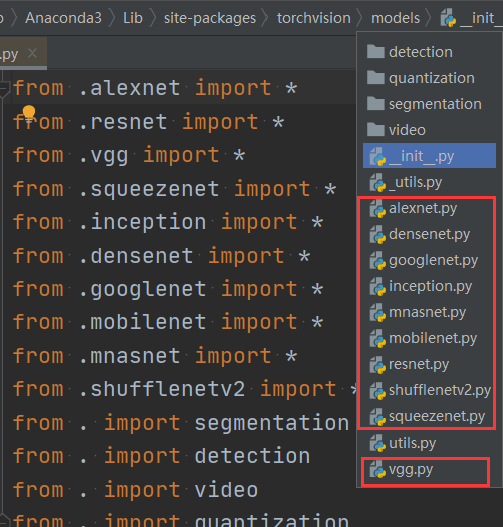
可以分类 3 类:
ResNet18 使用
ResNet 18 为例。
然后比较重要的是把模型放到 GPU 上,并且转换到`eval`模式:
resnet18 = models.resnet18()
# 修改全连接层的输出
num_ftrs = resnet18.fc.in_features
resnet18.fc = nn.Linear(num_ftrs, 2)
# 加载模型参数
checkpoint = torch.load(m_path)
resnet18.load_state_dict(checkpoint[‘model_state_dict‘])
resnet18.to(device)
resnet18.eval()
with torch.no_grad():下。torch.no_grad()会关闭反向传播,可以减少内存、加快速度。unsqueeze_(0)方法把形状扩大为 \(B \times C \times H \times W\),再把 tensor 放到 GPU 上 。outputs的形状是 $1 \times 2$,表示 batch_size 为 1,分类数量为 2。torch.max(outputs,0)是返回outputs中每一列最大的元素和索引,torch.max(outputs,1)是返回outputs中每一行最大的元素和索引。_, pred_int = torch.max(outputs.data, 1)返回最大元素的索引,然后根据索引获得 label:pred_str = classes[int(pred_int)]。 with torch.no_grad():
for idx, img_name in enumerate(img_names):
path_img = os.path.join(img_dir, img_name)
# step 1/4 : path --> img
img_rgb = Image.open(path_img).convert(‘RGB‘)
# step 2/4 : img --> tensor
img_tensor = img_transform(img_rgb, inference_transform)
img_tensor.unsqueeze_(0)
img_tensor = img_tensor.to(device)
# step 3/4 : tensor --> vector
outputs = resnet18(img_tensor)
# step 4/4 : get label
_, pred_int = torch.max(outputs.data, 1)
pred_str = classes[int(pred_int)]
import os
import time
import torch.nn as nn
import torch
import torchvision.transforms as transforms
from PIL import Image
from matplotlib import pyplot as plt
import torchvision.models as models
import enviroments
BASE_DIR = os.path.dirname(os.path.abspath(__file__))
# device = torch.device("cuda" if torch.cuda.is_available() else "cpu")
device = torch.device("cpu")
# config
vis = True
# vis = False
vis_row = 4
norm_mean = [0.485, 0.456, 0.406]
norm_std = [0.229, 0.224, 0.225]
inference_transform = transforms.Compose([
transforms.Resize(256),
transforms.CenterCrop(224),
transforms.ToTensor(),
transforms.Normalize(norm_mean, norm_std),
])
classes = ["ants", "bees"]
def img_transform(img_rgb, transform=None):
"""
将数据转换为模型读取的形式
:param img_rgb: PIL Image
:param transform: torchvision.transform
:return: tensor
"""
if transform is None:
raise ValueError("找不到transform!必须有transform对img进行处理")
img_t = transform(img_rgb)
return img_t
def get_img_name(img_dir, format="jpg"):
"""
获取文件夹下format格式的文件名
:param img_dir: str
:param format: str
:return: list
"""
file_names = os.listdir(img_dir)
# 使用 list(filter(lambda())) 筛选出 jpg 后缀的文件
img_names = list(filter(lambda x: x.endswith(format), file_names))
if len(img_names) img
img_rgb = Image.open(path_img).convert(‘RGB‘)
# step 2/4 : img --> tensor
img_tensor = img_transform(img_rgb, inference_transform)
img_tensor.unsqueeze_(0)
img_tensor = img_tensor.to(device)
# step 3/4 : tensor --> vector
time_tic = time.time()
outputs = resnet18(img_tensor)
time_toc = time.time()
# step 4/4 : visualization
_, pred_int = torch.max(outputs.data, 1)
pred_str = classes[int(pred_int)]
if vis:
img_list.append(img_rgb)
img_pred.append(pred_str)
if (idx+1) % (vis_row*vis_row) == 0 or num_img == idx+1:
for i in range(len(img_list)):
plt.subplot(vis_row, vis_row, i+1).imshow(img_list[i])
plt.title("predict:{}".format(img_pred[i]))
plt.show()
plt.close()
img_list, img_pred = list(), list()
time_s = time_toc-time_tic
time_total += time_s
print(‘{:d}/{:d}: {} {:.3f}s ‘.format(idx + 1, num_img, img_name, time_s))
print("\ndevice:{} total time:{:.1f}s mean:{:.3f}s".
format(device, time_total, time_total/num_img))
if torch.cuda.is_available():
print("GPU name:{}".format(torch.cuda.get_device_name()))
残差连接
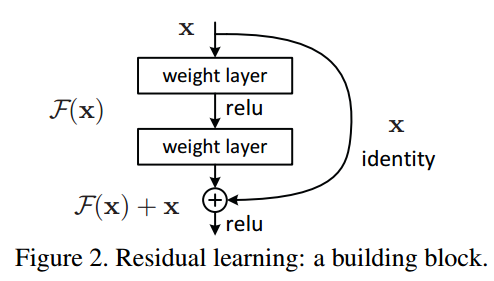
一个残差块有2条路径 $F(x)$ 和 $x$,$F(x)$ 路径拟合残差,不妨称之为残差路径;$x$ 路径为`identity mapping`恒等映射,称之为`shortcut`。图中的⊕为`element-wise addition`,要求参与运算的 $F(x)$ 和 $x$ 的尺寸要相同。
shortcut 路径大致可以分成 2 种,取决于残差路径是否改变了feature map数量和尺寸。
x原封不动地输出。shape一致,对网络性能的提升并不明显。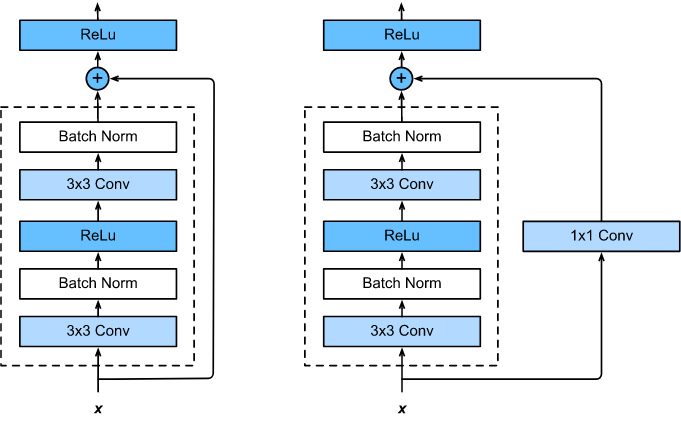
`ResNet` 中,使用了上面 2 种 `shortcut`。
网络结构
ResNet 18、ResNet 34、ResNet 50、ResNet 101、ResNet 152,网络结构对比如下: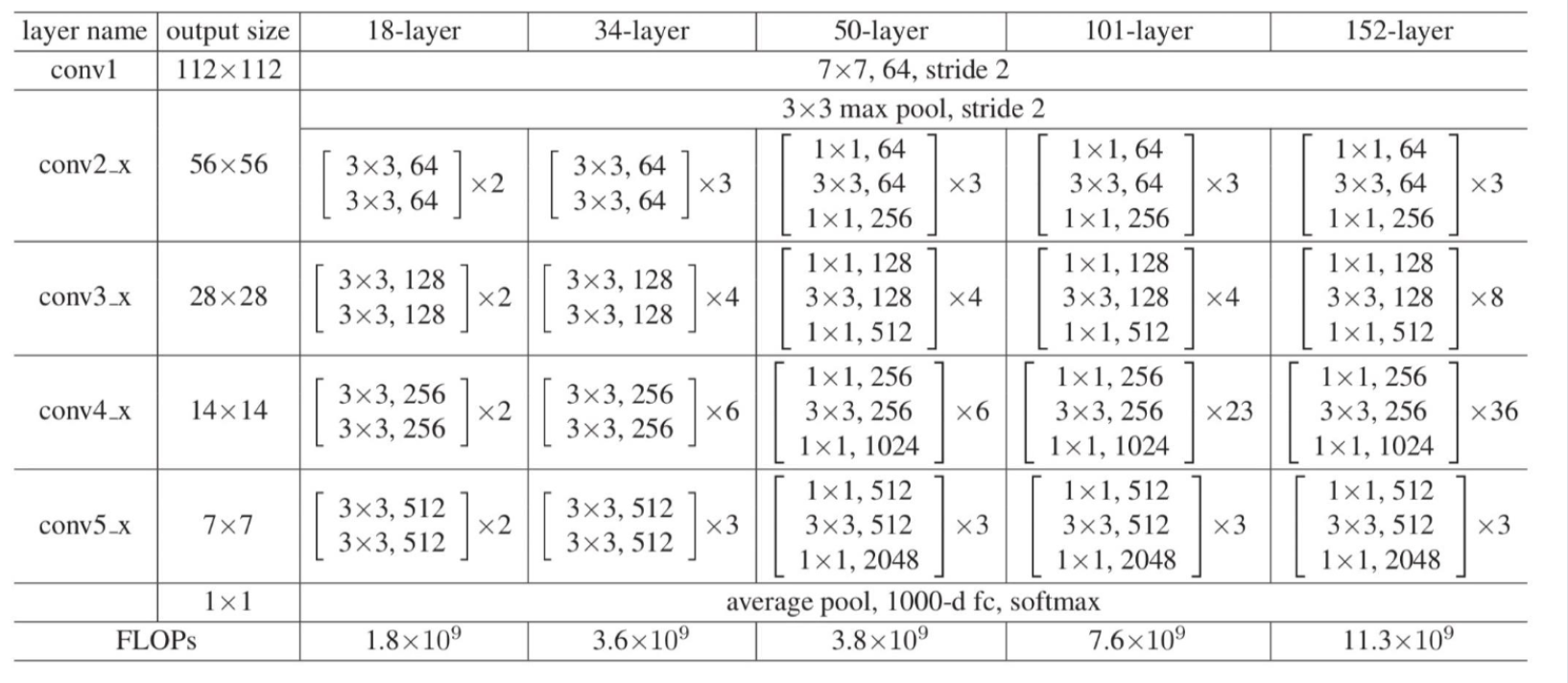
`ResNet` 的各个变种,数据处理大致流程如下:
conv1 层,输出图片大小为 $ 64 \times 112 \times 112$。max pool 层,输出图片大小为 \(64 \times 56 \times 56\)。conv2 层,输出图片大小为 $ 64 \times 56 \times 56$。(注意,图片经过这个 layer, 大小是不变的)
conv3 层,输出图片大小为 $ 128 \times 28 \times 28$。conv4 层,输出图片大小为 $ 256 \times 14 \times 14$。conv5 层,输出图片大小为 $ 512 \times 7 \times 7$。avg pool 层,输出大小为 $ 512 \times 1 \times 1$。fc 层,输出维度为 $ num_classes$,表示每个分类的 logits。conv 层为一个 layer(第一个 conv 层就是一个卷积层,因此第一个 conv 层除外)。ResNet 18、ResNet 34 的每个 layer 由多个 BasicBlock 组成,只是每个 layer 里堆叠的 BasicBlock 数量不一样。ResNet 50、ResNet 101、ResNet 152 的每个 layer 由多个 Bottleneck 组成,只是每个 layer 里堆叠的 Bottleneck 数量不一样。源码分析
ResNet 的源码,首先从构造函数开始。构造函数
ResNet 18
resnet18 的构造函数如下。[2, 2, 2, 2] 表示有 4 个 layer,每个 layer 中有 2 个 BasicBlock。conv1为 1 层,conv2、conv3、conv4、conv5均为 4 层(每个 layer 有 2 个 BasicBlock,每个 BasicBlock 有 2 个卷积层),总共为 16 层,最后一层全连接层,$ 总层数 = 1+ 4 \times 4 + 1 = 18$,依此类推。def resnet18(pretrained=False, progress=True, **kwargs):
r"""ResNet-18 model from
`"Deep Residual Learning for Image Recognition" ResNet 34
resnet 34 的构造函数如下。[3, 4, 6, 3] 表示有 4 个 layer,每个 layer 的 BasicBlock 数量分别为 3, 4, 6, 3。def resnet34(pretrained=False, progress=True, **kwargs):
r"""ResNet-34 model from
`"Deep Residual Learning for Image Recognition" ResNet 50
resnet 34 的构造函数如下。[3, 4, 6, 3] 表示有 4 个 layer,每个 layer 的 Bottleneck 数量分别为 3, 4, 6, 3。def resnet50(pretrained=False, progress=True, **kwargs):
r"""ResNet-50 model from
`"Deep Residual Learning for Image Recognition" ResNet 101 和 ResNet 152 也是由多个 layer 组成的。_resnet()
_resnet() 方法来创建网络,下面来看看 _resnet() 方法。def _resnet(arch, block, layers, pretrained, progress, **kwargs):
model = ResNet(block, layers, **kwargs)
# 加载预训练好的模型参数
if pretrained:
state_dict = load_state_dict_from_url(model_urls[arch],
progress=progress)
model.load_state_dict(state_dict)
return model
_resnet() 方法中,又调用了 ResNet() 方法创建模型,然后加载训练好的模型参数。ResNet()
ResNet() 方法的构造函数。构造函数
layer 里面使用的 block,可以是 BasicBlock Bottleneck。layer 中 block 的数量。
norm_layer,没有传入,则使用 BatchNorm2d。replace_stride_with_dilation,如果不指定,则赋值为 [False, False, False],表示不使用孔洞卷积。groups,width_per_group。conv1 层的结构是 Conv2d -> norm_layer -> ReLU。self.conv1 = nn.Conv2d(3, self.inplanes, kernel_size=7, stride=2, padding=3, bias=False)
self.bn1 = norm_layer(self.inplanes)
self.relu = nn.ReLU(inplace=True)
conv2 层的代码如下,对应于 layer1,这个 layer 的参数没有指定 stride,默认 stride=1,因此这个 layer 不会改变图片大小:self.layer1 = self._make_layer(block, 64, layers[0])
conv3 层的代码如下,对应于 layer2(注意这个 layer 指定 stride=2,会降采样,详情看下面 _make_layer 的讲解):self.layer2 = self._make_layer(block, 128, layers[1], stride=2, dilate=replace_stride_with_dilation[0])
conv4 层的代码如下,对应于 layer3(注意这个 layer 指定 stride=2,会降采样,详情看下面 _make_layer 的讲解):self.layer3 = self._make_layer(block, 256, layers[2], stride=2,
dilate=replace_stride_with_dilation[1])
conv5 层的代码如下,对应于 layer4(注意这个 layer 指定 stride=2,会降采样,详情看下面 _make_layer 的讲解):self.layer4 = self._make_layer(block, 512, layers[3], stride=2,
dilate=replace_stride_with_dilation[2])
AdaptiveAvgPool2d 层和 fc 层。
kaiming_normal_() 初始化方法。bn 层和 GroupNorm 层初始化为 weight=1,bias=0。BasicBlock 和 Bottleneck 的最后一层 bn 的 weight=0,可以提升准确率 0.2~0.3%。 def __init__(self, block, layers, num_classes=1000, zero_init_residual=False,
groups=1, width_per_group=64, replace_stride_with_dilation=None,
norm_layer=None):
super(ResNet, self).__init__()
# 使用 bn 层
if norm_layer is None:
norm_layer = nn.BatchNorm2d
self._norm_layer = norm_layer
self.inplanes = 64
self.dilation = 1
if replace_stride_with_dilation is None:
# each element in the tuple indicates if we should replace
# the 2x2 stride with a dilated convolution instead
replace_stride_with_dilation = [False, False, False]
if len(replace_stride_with_dilation) != 3:
raise ValueError("replace_stride_with_dilation should be None "
"or a 3-element tuple, got {}".format(replace_stride_with_dilation))
self.groups = groups
self.base_width = width_per_group
# 对应于 conv1
self.conv1 = nn.Conv2d(3, self.inplanes, kernel_size=7, stride=2, padding=3,
bias=False)
self.bn1 = norm_layer(self.inplanes)
self.relu = nn.ReLU(inplace=True)
# 对应于 conv2
self.maxpool = nn.MaxPool2d(kernel_size=3, stride=2, padding=1)
self.layer1 = self._make_layer(block, 64, layers[0])
# 对应于 conv3
self.layer2 = self._make_layer(block, 128, layers[1], stride=2,
dilate=replace_stride_with_dilation[0])
对应于 conv4
self.layer3 = self._make_layer(block, 256, layers[2], stride=2,
dilate=replace_stride_with_dilation[1])
对应于 conv5
self.layer4 = self._make_layer(block, 512, layers[3], stride=2,
dilate=replace_stride_with_dilation[2])
self.avgpool = nn.AdaptiveAvgPool2d((1, 1))
self.fc = nn.Linear(512 * block.expansion, num_classes)
for m in self.modules():
if isinstance(m, nn.Conv2d):
nn.init.kaiming_normal_(m.weight, mode=‘fan_out‘, nonlinearity=‘relu‘)
elif isinstance(m, (nn.BatchNorm2d, nn.GroupNorm)):
nn.init.constant_(m.weight, 1)
nn.init.constant_(m.bias, 0)
# Zero-initialize the last BN in each residual branch,
# so that the residual branch starts with zeros, and each residual block behaves like an identity.
# This improves the model by 0.2~0.3% according to https://arxiv.org/abs/1706.02677
if zero_init_residual:
for m in self.modules():
if isinstance(m, Bottleneck):
nn.init.constant_(m.bn3.weight, 0)
elif isinstance(m, BasicBlock):
nn.init.constant_(m.bn2.weight, 0)
forward()
ResNet 中,网络经过层层封装,因此forward() 方法非常简洁。
conv1 层,输出图片大小为 $ 64 \times 112 \times 112$。max pool 层,输出图片大小为 \(64 \times 56 \times 56\)。ResNet 18、ResNet 34 (使用 BasicBlock):
conv2 层,对应于 layer1,输出图片大小为 $ 64 \times 56 \times 56$。(注意,图片经过这个 layer, 大小是不变的)
conv3 层,对应于 layer2,输出图片大小为 $ 128 \times 28 \times 28$。conv4 层,对应于 layer3,输出图片大小为 $ 256 \times 14 \times 14$。conv5 层,对应于 layer4,输出图片大小为 $ 512 \times 7 \times 7$。avg pool 层,输出大小为 $ 512 \times 1 \times 1$。ResNet 50、ResNet 101、ResNet 152(使用 Bottleneck):
conv2 层,对应于 layer1,输出图片大小为 $ 256 \times 56 \times 56$。(注意,图片经过这个 layer, 大小是不变的)
conv3 层,对应于 layer2,输出图片大小为 $ 512 \times 28 \times 28$。conv4 层,对应于 layer3,输出图片大小为 $ 1024 \times 14 \times 14$。conv5 层,对应于 layer4,输出图片大小为 $ 2048 \times 7 \times 7$。avg pool 层,输出大小为 $ 2048 \times 1 \times 1$。fc 层,输出维度为 $ num_classes$,表示每个分类的 logits。 def _forward_impl(self, x):
# See note [TorchScript super()]
# conv1
# x: [3, 224, 224] -> [64, 112, 112]
x = self.conv1(x)
x = self.bn1(x)
x = self.relu(x)
# conv2
# x: [64, 112, 112] -> [64, 56, 56]
x = self.maxpool(x)
# x: [64, 56, 56] -> [64, 56, 56]
# x 经过第一个 layer, 大小是不变的
x = self.layer1(x)
# conv3
# x: [64, 56, 56] -> [128, 28, 28]
x = self.layer2(x)
# conv4
# x: [128, 28, 28] -> [256, 14, 14]
x = self.layer3(x)
# conv5
# x: [256, 14, 14] -> [512, 7, 7]
x = self.layer4(x)
# x: [512, 7, 7] -> [512, 1, 1]
x = self.avgpool(x)
x = torch.flatten(x, 1)
x = self.fc(x)
return x
layer 都是使用 _make_layer() 方法来创建层的,下面来看下 _make_layer() 方法。_make_layer()
_make_layer()方法的参数如下:
layer 里面使用的 block,可以是 BasicBlock,Bottleneck。layer 有多少个 block。block 的卷积层的 stride,默认为 1。注意,只有在每个 layer 的第一个 block 的第一个卷积层使用该参数。
previous_dilation 参数。stride 是否为 1,输入通道和输出通道是否相等。如果这两个条件都不成立,那么表明需要建立一个 1 X 1 的卷积层,来改变通道数和改变图片大小。具体是建立 downsample 层,包括 conv1x1 -> norm_layer。block,把 downsample 传给 block 作为降采样的层,并且 stride 也使用传入的 stride(stride=2)。后面我们会分析 downsample 层在 BasicBlock 和 Bottleneck 中,具体是怎么用的。self.inplanes = planes * block.expansion。
BasicBlock 里,expansion=1,因此这一步不会改变通道数。Bottleneck 里,expansion=4,因此这一步会改变通道数。block后,就会改变通道数和图片大小。接下来 for 循环添加剩下的 block。从第 2 个 block 起,输入和输出通道数是相等的,因此就不用传入 downsample 和 stride(那么 block 的 stride 默认使用 1,下面我们会分析 BasicBlock 和 Bottleneck 的源码)。 def _make_layer(self, block, planes, blocks, stride=1, dilate=False):
norm_layer = self._norm_layer
downsample = None
previous_dilation = self.dilation
if dilate:
self.dilation *= stride
stride = 1
# 首先判断 stride 是否为1,输入通道和输出通道是否相等。不相等则使用 1 X 1 的卷积改变大小和通道
#作为 downsample
# 在 Resnet 中,每层 layer 传入的 stride =2
if stride != 1 or self.inplanes != planes * block.expansion:
downsample = nn.Sequential(
conv1x1(self.inplanes, planes * block.expansion, stride),
norm_layer(planes * block.expansion),
)
layers = []
# 然后添加第一个 basic block,把 downsample 传给 BasicBlock 作为降采样的层。
layers.append(block(self.inplanes, planes, stride, downsample, self.groups,
self.base_width, previous_dilation, norm_layer))
# 修改输出的通道数
self.inplanes = planes * block.expansion
# 继续添加这个 layer 里接下来的 BasicBlock
for _ in range(1, blocks):
layers.append(block(self.inplanes, planes, groups=self.groups,
base_width=self.base_width, dilation=self.dilation,
norm_layer=norm_layer))
return nn.Sequential(*layers)
BasicBlock 和 Bottleneck 的源码。BasicBlock
构造函数
BasicBlock 构造函数的主要参数如下:
stride。layer 中传入的 downsample 层。
norm_layer 层,如果没有,则使用 BatchNorm2d。groups == 1,base_width == 64,dilation == 1。也就是说,在 BasicBlock 中,不使用孔洞卷积和分组卷积。conv3x3 -> norm_layer -> relu,这里使用传入的 stride 和 inplanes。(如果是 layer2 ,layer3 ,layer4 里的第一个 BasicBlock,那么 stride=2,这里会降采样和改变通道数)。conv3x3 -> norm_layer -> relu,这里不使用传入的 stride (默认为 1),输入通道数和输出通道数使用planes,也就是不需要降采样和改变通道数。class BasicBlock(nn.Module):
expansion = 1
__constants__ = [‘downsample‘]
def __init__(self, inplanes, planes, stride=1, downsample=None, groups=1,
base_width=64, dilation=1, norm_layer=None):
super(BasicBlock, self).__init__()
if norm_layer is None:
norm_layer = nn.BatchNorm2d
if groups != 1 or base_width != 64:
raise ValueError(‘BasicBlock only supports groups=1 and base_width=64‘)
if dilation > 1:
raise NotImplementedError("Dilation > 1 not supported in BasicBlock")
# Both self.conv1 and self.downsample layers downsample the input when stride != 1
self.conv1 = conv3x3(inplanes, planes, stride)
self.bn1 = norm_layer(planes)
self.relu = nn.ReLU(inplace=True)
self.conv2 = conv3x3(planes, planes)
self.bn2 = norm_layer(planes)
self.downsample = downsample
self.stride = stride
forward()
forward() 方法的主要流程如下:
x 赋值给 identity,用于后面的 shortcut 连接。x 经过第 1 组 conv3x3 -> norm_layer -> relu,如果是 layer2 ,layer3 ,layer4 里的第一个 BasicBlock,那么 stride=2,第一个卷积层会降采样。x 经过第 1 组 conv3x3 -> norm_layer,得到 out。layer2 ,layer3 ,layer4 里的第一个 BasicBlock,那么 downsample 不为空,会经过 downsample 层,得到 identity。identity 和 out 相加,经过 relu ,得到输出。
relu 层,但它们使用的是同一个 relu 层。 def forward(self, x):
identity = x
# 如果是 layer2,layer3,layer4 里的第一个 BasicBlock,第一个卷积层会降采样
out = self.conv1(x)
out = self.bn1(out)
out = self.relu(out)
out = self.conv2(out)
out = self.bn2(out)
if self.downsample is not None:
identity = self.downsample(x)
out += identity
out = self.relu(out)
return out
Bottleneck
构造函数
stride。layer 中传入的 downsample 层。
norm_layer 层,如果没有,则使用 BatchNorm2d。width,等于传入的 planes,用于中间的 \(3 \times 3\) 卷积。conv1x1 -> norm_layer,这里不使用传入的 stride,使用 width,作用是进行降维,减少通道数。conv3x3 -> norm_layer,这里使用传入的 stride,输入通道数和输出通道数使用width。(如果是 layer2 ,layer3 ,layer4 里的第一个 Bottleneck,那么 stride=2,这里会降采样)。conv1x1 -> norm_layer,这里不使用传入的 stride,使用 planes * self.expansion,作用是进行升维,增加通道数。class Bottleneck(nn.Module):
expansion = 4
__constants__ = [‘downsample‘]
def __init__(self, inplanes, planes, stride=1, downsample=None, groups=1,
base_width=64, dilation=1, norm_layer=None):
super(Bottleneck, self).__init__()
if norm_layer is None:
norm_layer = nn.BatchNorm2d
# base_width = 64
# groups =1
# width = planes
width = int(planes * (base_width / 64.)) * groups
# Both self.conv2 and self.downsample layers downsample the input when stride != 1
# 1x1 的卷积是为了降维,减少通道数
self.conv1 = conv1x1(inplanes, width)
self.bn1 = norm_layer(width)
# 3x3 的卷积是为了改变图片大小,不改变通道数
self.conv2 = conv3x3(width, width, stride, groups, dilation)
self.bn2 = norm_layer(width)
# 1x1 的卷积是为了升维,增加通道数,增加到 planes * 4
self.conv3 = conv1x1(width, planes * self.expansion)
self.bn3 = norm_layer(planes * self.expansion)
self.relu = nn.ReLU(inplace=True)
self.downsample = downsample
self.stride = stride
forward()
forward() 方法的主要流程如下:
x 赋值给 identity,用于后面的 shortcut 连接。x 经过第 1 组 conv1x1 -> norm_layer -> relu,作用是进行降维,减少通道数。x 经过第 2 组 conv3x3 -> norm_layer -> relu。如果是 layer2 ,layer3 ,layer4 里的第一个 Bottleneck,那么 stride=2,第一个卷积层会降采样。x 经过第 1 组 conv1x1 -> norm_layer -> relu,作用是进行降维,减少通道数。layer2 ,layer3 ,layer4 里的第一个 Bottleneck,那么 downsample 不为空,会经过 downsample 层,得到 identity。identity 和 out 相加,经过 relu ,得到输出。
relu 层,但它们使用的是同一个 relu 层。 def forward(self, x):
identity = x
out = self.conv1(x)
out = self.bn1(out)
out = self.relu(out)
out = self.conv2(out)
out = self.bn2(out)
out = self.relu(out)
out = self.conv3(out)
out = self.bn3(out)
if self.downsample is not None:
identity = self.downsample(x)
out += identity
out = self.relu(out)
return out
总结
BasicBlock 中有 1 个 $3 \times 3 $ 卷积层,如果是 layer 的第一个 BasicBlock,那么第一个卷积层的 stride=2,作用是进行降采样。Bottleneck 中有 2 个 $1 \times 1 $ 卷积层, 1 个 $3 \times 3 $ 卷积层。先经过第 1 个 $1 \times 1 $ 卷积层,进行降维,然后经过 $3 \times 3 $ 卷积层(如果是 layer 的第一个 Bottleneck,那么 $3 \times 3 $ 卷积层的 stride=2,作用是进行降采样),最后经过 $1 \times 1 $ 卷积层,进行升维 。ResNet 18 图解
layer1
ResNet 18 ,使用的是 BasicBlock。layer1,特点是没有进行降采样,卷积层的 stride = 1,不会降采样。在进行 shortcut 连接时,也没有经过 downsample 层。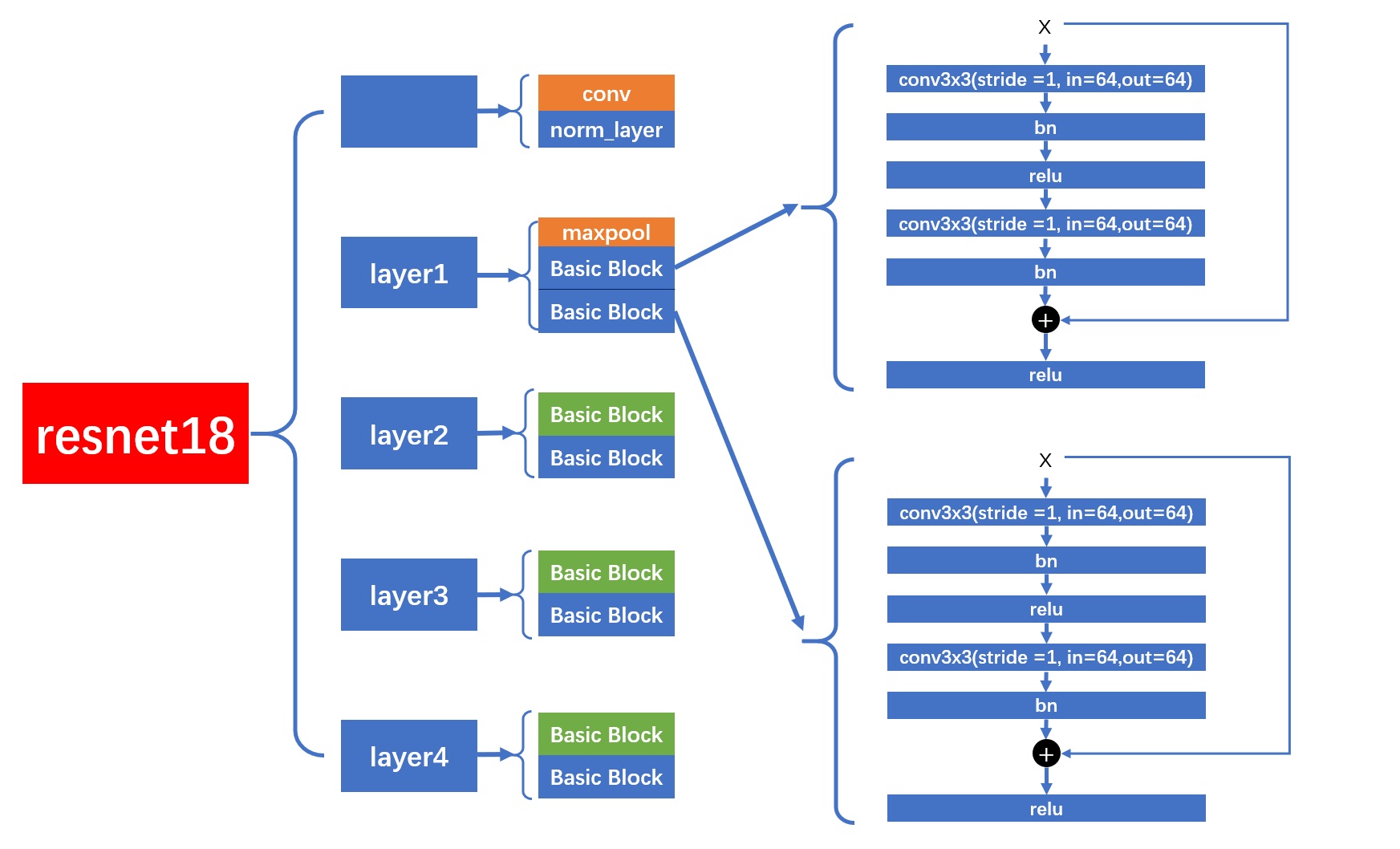
layer2,layer3,layer4
layer2,layer3,layer4 的结构图如下,每个 layer 包含 2 个 BasicBlock,但是第 1 个 BasicBlock 的第 1 个卷积层的 stride = 2,会进行降采样。在进行 shortcut 连接时,会经过 downsample 层,进行降采样和降维。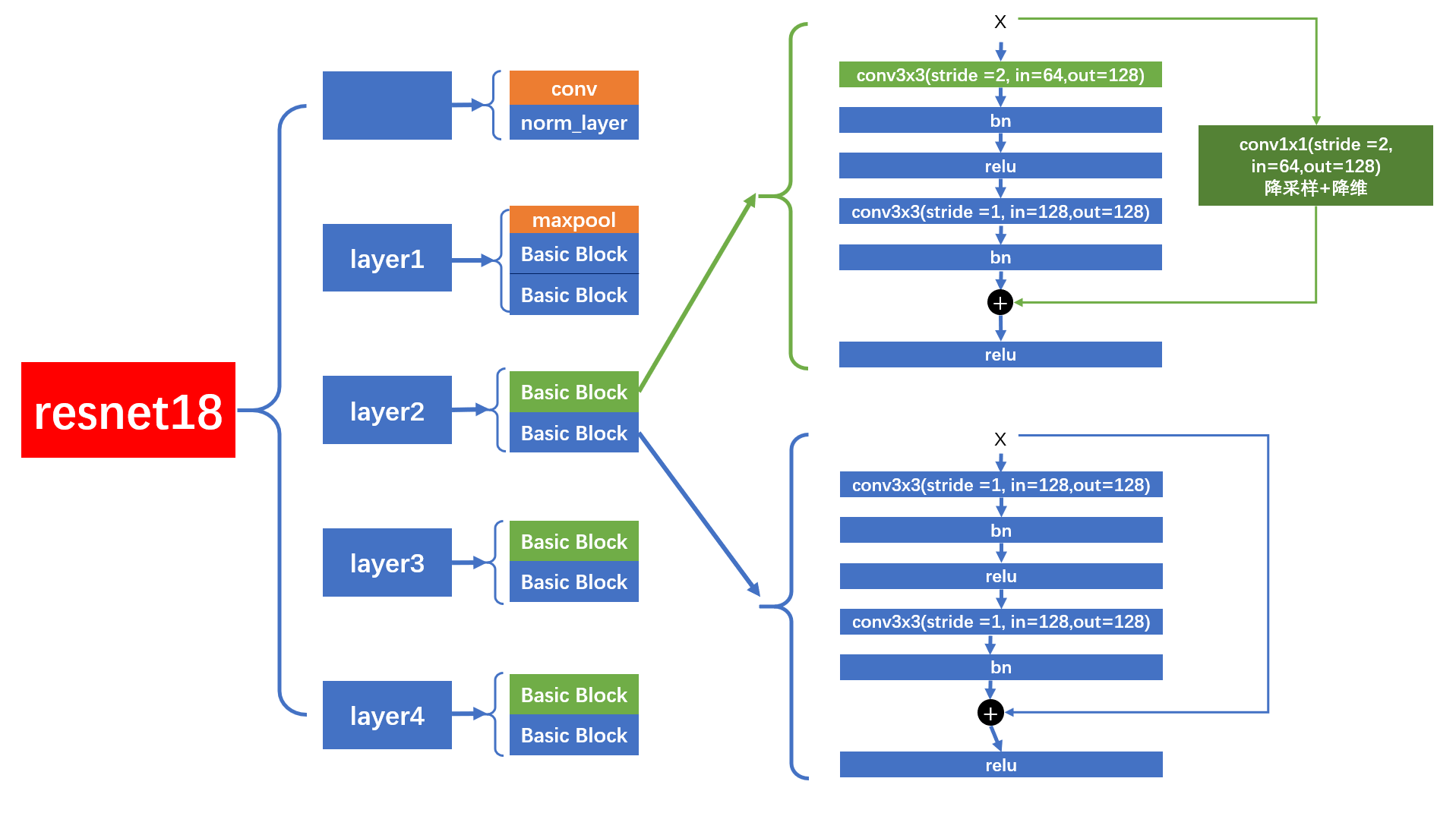
ResNet 50 图解
layer1
layer1 中,首先第一个 Bottleneck 只会进行升维,不会降采样。shortcut 连接前,会经过 downsample 层升维处理。第二个 Bottleneck 的 shortcut 连接不会经过 downsample 层。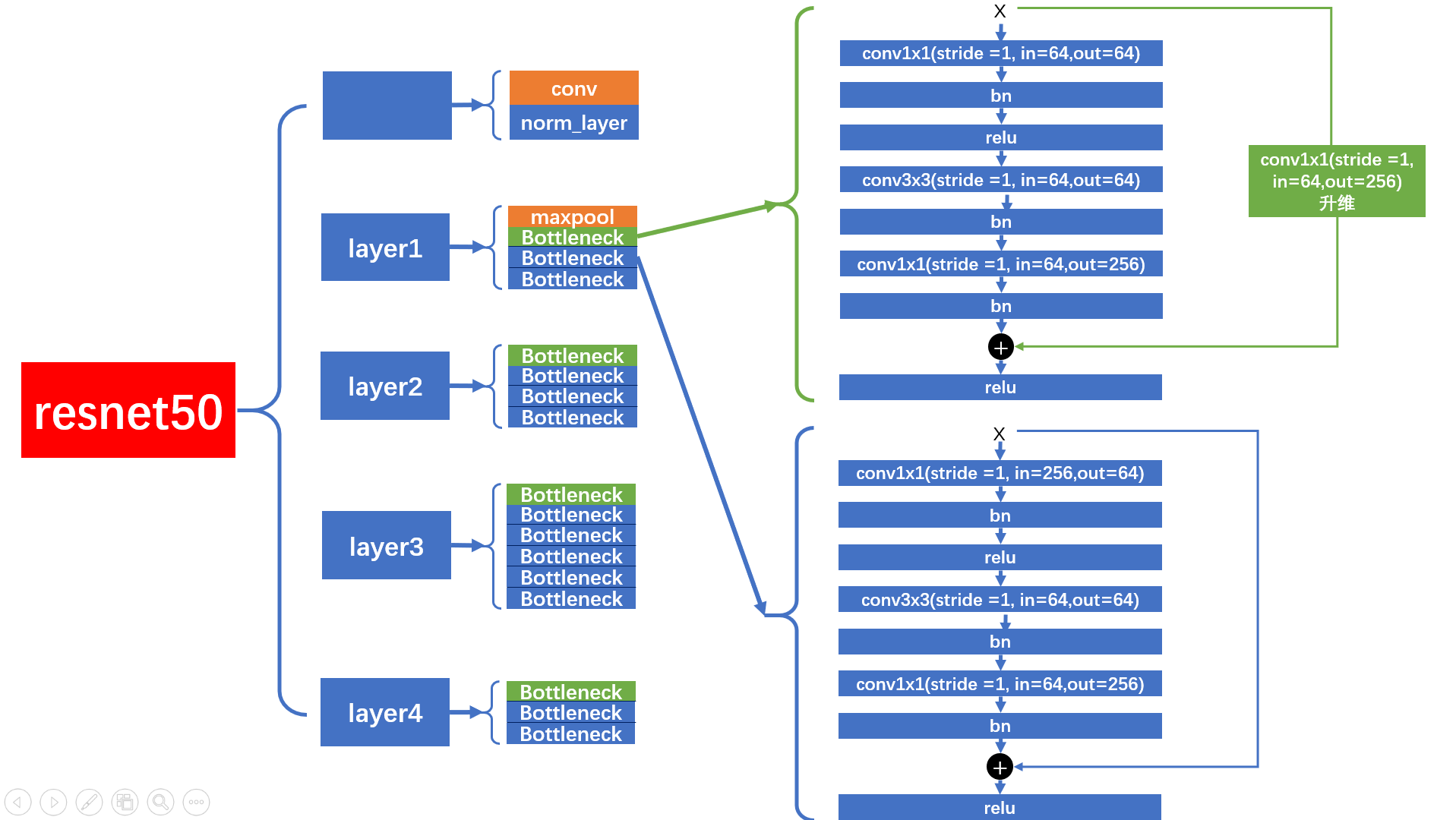
layer2,layer3,layer4
layer2,layer3,layer4 的结构图如下,每个 layer 包含多个 Bottleneck,但是第 1 个 Bottleneck 的 \(3 \times 3\) 卷积层的 stride = 2,会进行降采样。在进行 shortcut 连接时,会经过 downsample 层,进行降采样和降维。